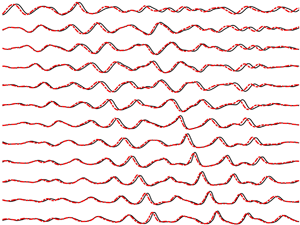Crossref Citations
This article has been cited by the following publications. This list is generated based on data provided by
Crossref.
Kimmoun, Olivier
Hsu, Hung-Chu
Hoffmann, Norbert
and
Chabchoub, Amin
2021.
Experiments on uni-directional and nonlinear wave group shoaling.
Ocean Dynamics,
Vol. 71,
Issue. 11-12,
p.
1105.
Li, Yan
Draycott, Samuel
Zheng, Yaokun
Lin, Zhiliang
Adcock, Thomas A.A.
and
van den Bremer, Ton S.
2021.
Why rogue waves occur atop abrupt depth transitions.
Journal of Fluid Mechanics,
Vol. 919,
Issue. ,
Li, Yan
and
Li, Xin
2021.
Weakly nonlinear broadband and multi-directional surface waves on an arbitrary depth: A framework, Stokes drift, and particle trajectories.
Physics of Fluids,
Vol. 33,
Issue. 7,
Ducrozet, G.
Slunyaev, A. V.
and
Stepanyants, Y. A.
2021.
Transformation of envelope solitons on a bottom step.
Physics of Fluids,
Vol. 33,
Issue. 6,
Lawrence, Christopher
Trulsen, Karsten
and
Gramstad, Odin
2022.
Extreme wave statistics of surface elevation and velocity field of gravity waves over a two-dimensional bathymetry.
Journal of Fluid Mechanics,
Vol. 939,
Issue. ,
Ma, Yuxiang
Zhang, Jie
Chen, Qunbin
Tai, Bing
Dong, Guohai
Xie, Botao
and
Niu, Xuyang
2022.
Progresses in the Research of Oceanic Freak Waves: Mechanism, Modeling, and Forecasting.
International Journal of Ocean and Coastal Engineering,
Vol. 04,
Issue. 01n02,
Mendes, S.
Scotti, A.
Brunetti, M.
and
Kasparian, J.
2022.
Non-homogeneous analysis of rogue wave probability evolution over a shoal.
Journal of Fluid Mechanics,
Vol. 939,
Issue. ,
Zhang, Xufeng
Zhang, Yifeng
and
Li, Ruijie
2022.
The Fourth-Order Nonlinear Schrödinger Equation and Stability Analysis for Stokes Waves on Slowly Varying Topography.
Frontiers in Marine Science,
Vol. 9,
Issue. ,
Yang, Hongkuan
Guo, Zhen
Wang, Lizhong
Dou, Yuzhe
and
Liu, Zhenyu
2022.
Experimental study on wave-induced seabed response and force on the pipeline shallowly buried in a submerged sandy slope.
Ocean Engineering,
Vol. 251,
Issue. ,
p.
111153.
Liu, Weijie
Liu, Yushi
Zhao, Xizeng
and
Ning, Yue
2022.
Numerical study of irregular wave propagation over sinusoidal bars on the reef flat.
Applied Ocean Research,
Vol. 121,
Issue. ,
p.
103114.
Zhang, Jie
Benoit, Michel
and
Ma, Yuxiang
2022.
Equilibration process of out-of-equilibrium sea-states induced by strong depth variation: Evolution of coastal wave spectrum and representative parameters.
Coastal Engineering,
Vol. 174,
Issue. ,
p.
104099.
Liu, S.
Waseda, T.
and
Zhang, X.
2022.
Four-wave resonant interaction of surface gravity waves in finite water depth.
Physical Review Fluids,
Vol. 7,
Issue. 11,
Latifah, A.L.
Shabrina, A.
and
Handri, D.
2022.
Simulations of long-crested wind waves over the shallow seamount at Glagah.
Applied Ocean Research,
Vol. 129,
Issue. ,
p.
103366.
Slunyaev, Alexey V.
Pelinovsky, Dmitrii E.
and
Pelinovsky, Efim N.
2023.
Rogue waves in the sea: observations, physics, and mathematics.
Physics-Uspekhi,
Vol. 66,
Issue. 02,
p.
148.
Cao, Xiangming
Shi, Jian
Zhang, Chi
and
Zheng, Jinhai
2023.
Inter-comparison of wave skewness and asymmetry estimation using wavelet, Fourier and statistical methods.
Ocean Engineering,
Vol. 268,
Issue. ,
p.
113382.
He, Yanli
Chen, Hongzhou
Yang, Hui
He, Dongbin
and
Dong, Guohai
2023.
Experimental investigation on the hydrodynamic characteristics of extreme wave groups over unidirectional sloping bathymetry.
Ocean Engineering,
Vol. 282,
Issue. ,
p.
114982.
Zhang, Jie
Ma, Yuxiang
Tan, Ting
Dong, Guohai
and
Benoit, Michel
2023.
Enhanced extreme wave statistics of irregular waves due to accelerating following current over a submerged bar.
Journal of Fluid Mechanics,
Vol. 954,
Issue. ,
He, Yanli
Wu, Guanglin
Mao, Hongfei
Chen, Hongzhou
Lin, Jinbo
and
Dong, Guohai
2023.
An experimental study on nonlinear wave dynamics for freak waves over an uneven bottom.
Frontiers in Marine Science,
Vol. 10,
Issue. ,
Teutsch, Ina
Brühl, Markus
Weisse, Ralf
and
Wahls, Sander
2023.
Contribution of solitons to enhanced rogue wave occurrence in shallow depths: a case study in the southern North Sea.
Natural Hazards and Earth System Sciences,
Vol. 23,
Issue. 6,
p.
2053.
Wu, Qian
Feng, Xingya
Dong, You
and
Dias, Frederic
2023.
On the behavior of higher harmonics in the evolution of nonlinear water waves in the presence of abrupt depth transitions.
Physics of Fluids,
Vol. 35,
Issue. 12,



